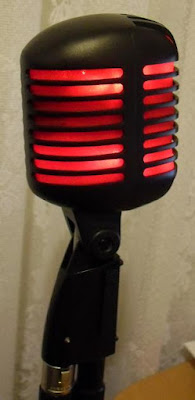
Dynamic Mic's With LED Lights
Tutorial on how to utilize 48v Phantom power with balanced dynamic microphones to drive L.E.D's for a great illuminated effect!
Tuesday, September 7, 2010
LED (Light Emitting Diode) Dynamic Microphone

Installing the LED frame


Mounting the LED’s
Once our frame is ready, start by drilling the holes in each corner to mount the frame to the mic chassis, and then determine the best position for each LED. For better and more even results, mount one LED in the each corner of the frame on each side, being four LED’s on the front & four LED’s on the Back. They don’t need to be in exactly the same position but close enough is good enough.
The frame in the example has ample room to mount the four 1w resistors, its important that they be placed somewhere that wont come in contact with anything else as they may dissipate some heat (if any). Looking at the schematic the best way to mount the resistors is the stack one on top of the other, wrap one resistors leads around the other and then solder them together so they are connected in parallel. This is ensure you will have a secure mount with only one lead at each end of the resistors to solder to the circuit. You can mount the components anyway you like, however with the limited room inside the mic chassis this seems to be a good spot.
When mounting the LED’s you can use each lead to join each LED together, use the holes in the protoboard & if need be gently twist each lead together with the next LED in series for extra support.
After you have connected the circuit and soldered in the LED’s the next step is to connect the ground wire, the best place is directly to Pin 1 of the XLR connector (main ground). If you cannot do this then find a good place that the chassis of the mic will allow you to ground the circuit like a mounting screw. In the picture below we soldered a ‘Solder Ring’ above one of the mounting holes in our frame so that when its screwed down the screw will make contact with the chassis (that is connected to Pin 1 of the XLR) closing our LED circuit.
The only thing left now is the solder two small wires from the resistors to the microphone circuit (Pins 2 & 3 of the XLR connector)
Before you put your frame in, test the circuit with an XLR cable to ensure it works. If testing is good then you can use some epoxy to cover the exposed LED leads & tracks for two reasons. To ensure your solder connections don’t come detached over time and to insulate the exposed leads so they don’t come into contact with the foam windscreen.
Finally mount the frame to the mic chassis & solder the two wires to the XLR connector (pins 2 & 3). In the Super 55 the solder pads make this easy.
Take great care when mounding the LED frame & ensure it does not come into any contact with the mic element.

Monday, September 6, 2010
LED Test Circuit


The circuit is designed for the LED’s to be connected in ‘series’ & for good reason. With the small current, we can draw from phantom power we need to keep the current drain requirements to a minimum. Connecting LED’s in series allows for the same current that one LED would require lighting all eight up whilst dividing the supply voltage each LED.

